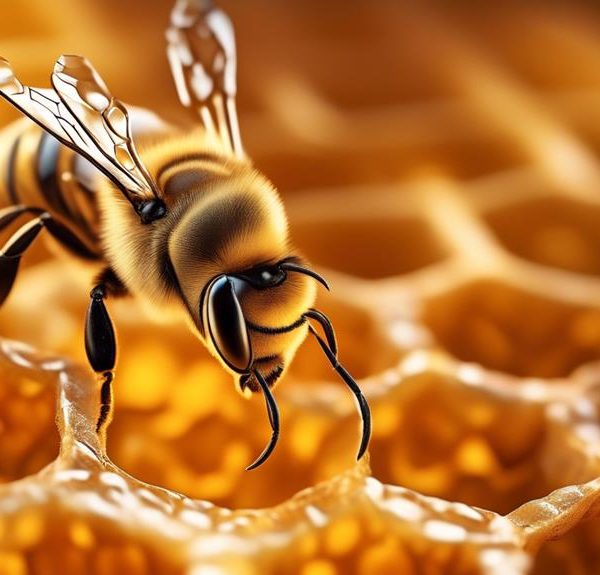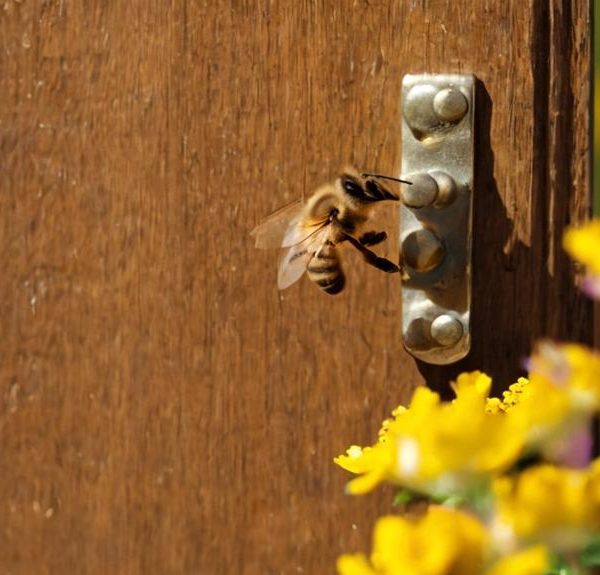Find out why bees buzz with activity in September, as they prepare for winter and face survival threats.
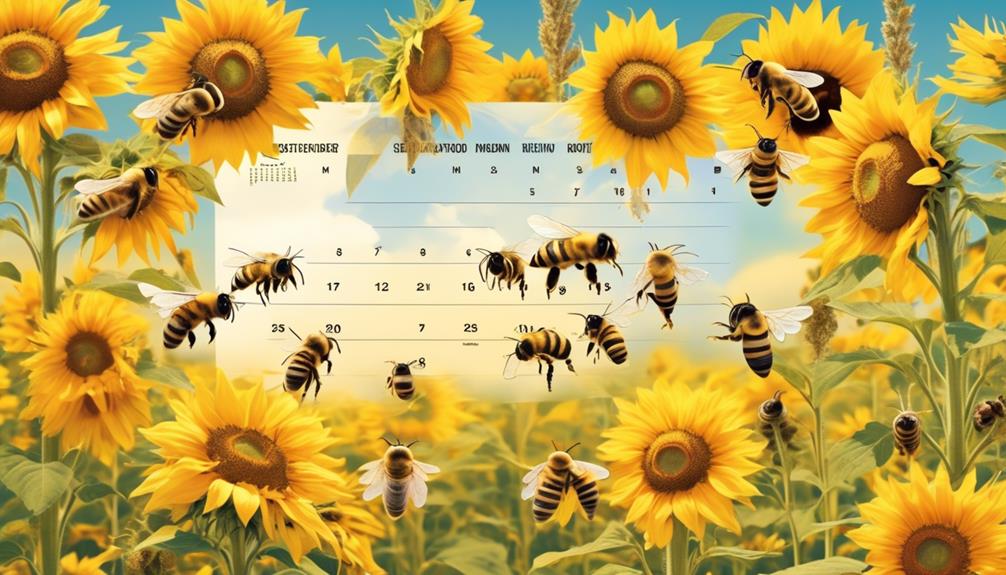
Why Are Bees Active in September
As the last golden rays of summer fade, you'll notice a sudden flurry of activity in your garden, with bees buzzing from flower to flower. This isn't a random occurrence or the bees' last-ditch attempt to enjoy the remnants of warm weather.
In fact, September plays a pivotal role in the life cycle of these industrious insects. You might wonder, 'Why are bees particularly active in September?' Well, the answer lies in the unique intersection of factors that this month brings: the preparation for winter, the pollination of autumn flowers, and the threats posed to their survival.
But there is more to this than meets the eye, and understanding the reasons behind their September industriousness can shed light on the delicate balance of nature. So, shall we explore this intriguing phenomenon further?
Key Takeaways
- September is an important month for bees as they engage in pollination activities, transferring pollen from one flower to another.
- Mild weather conditions and an abundance of flowering plants in September facilitate outdoor bee activities and aid in pollination.
- Bees undergo preparations for winter, including transitioning from summer foraging to survival strategies, producing a generation of winter bees, and fortifying the hive with propolis and pollen.
- Late-blooming flowers in autumn provide nectar and pollen for bees, fueling their flight muscles and metabolism, and serving as a crucial food source in winter.
Understanding Bee Life Cycle

Ever wondered about the fascinating life cycle of bees and how it impacts their activities in September? It's a complex process, driven by factors you may not have considered.
First, let's delve into the bee's life cycle. It starts when the queen bee lays an egg, which hatches into a larva. This larva is fed by worker bees and develops into a pupa, which eventually emerges as an adult bee.
This cycle, however, can change depending on environmental conditions. In the warmer months, a worker bee's lifespan is usually six weeks. But come winter, worker bees can live up to five months, as their role shifts from gathering nectar to keeping the queen warm.
So, why are bees active in September? Simply put, they're preparing for winter. They're gathering nectar to convert into honey, which will provide food during the colder months. They're also replacing their short-lived summer siblings, readying themselves to hunker down and protect their queen.
Understanding the bee's life cycle and its seasonal adaptations is crucial in appreciating their September activities. It's a testament to nature's ingenuity and the bee's resilience.
September's Role in Pollination

As September unfolds, you play witness to a vital phase in nature's calendar – pollination. Bees, acting as nature's diligent messengers, transfer pollen from one flower to another, ensuring the survival and propagation of many plant species. This process is crucial for biodiversity and the maintenance of food chains.
During this month, the weather conditions are typically mild, facilitating bees' outdoor activities. The abundance of flowering plants during this period further aids in this pollination process. You'll notice bees' heightened activity in gardens, parks, and other green spaces, as they tirelessly work to gather nectar and pollen.
The collected pollen sticks to their bodies, and when they move to the next flower, some of the pollen rubs off on the new flower's stigma. This transfer of pollen, called cross-pollination, results in the production of fertile seeds. The seeds then lead to the growth of a new generation of plants.
In this critical period, it's also important to note the role you can play in supporting bees. By providing a variety of flowering plants in your garden and avoiding chemical pesticides, you're not just aiding bees, but also contributing to the larger ecosystem.
Preparing for Winter: Bee Activity

While supporting bees in their September pollination activities is vital, it's equally crucial to understand and aid their preparation for the impending winter months. September marks a pivotal period of transition for bees, shifting from summer foraging to winter survival strategies. The queen's egg-laying slows, and worker bees begin producing a generation of winter bees, physiologically adapted to withstand the cold and survive on stored resources.
Bees reduce their hive's population to conserve energy and food. They also fortify their hive, sealing cracks with propolis, a resin-like substance, to keep out cold drafts. You'll notice bees collecting more pollen than nectar, as pollen is stored as a protein source for the winter bees during the non-foraging period.
Aiding bees in winter preparation can be as simple as limiting your disturbance of their hives and providing a stable supply of diverse flowering plants for pollen collection. Understanding these behavioral changes and their significance is your first step towards supporting bee populations effectively and preserving their crucial role in our ecosystem.
Impact of Autumn Flowers on Bees
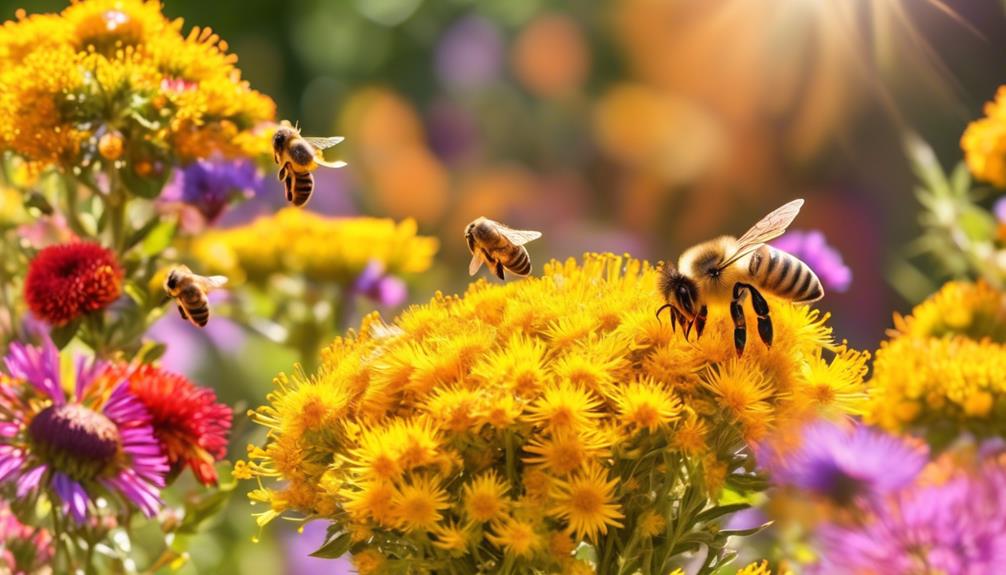
In your autumn garden, the presence of late-blooming flowers can significantly impact bees' ability to gather necessary resources for winter survival. These flora offer a valuable source of nectar and pollen when many other plants have ceased blooming. The diverse array of autumn flowers, such as asters, goldenrods, and sedums, aren't just aesthetically pleasing; they're critical to bees' sustenance.
The nectar from these flowers provides bees with carbohydrates, fueling their energy-intensive flight muscles and metabolism. It's also converted into honey, their main food source during the cold, food-scarce winter months. Similarly, the pollen offers protein, essential for larval growth and development. Without these nutrients, bees' health and their colony's overall survival can be seriously compromised.
Moreover, the availability of late-blooming flowers can affect the timing and success of bees' winter preparations. Bees that have access to these resources are more likely to successfully store enough food and produce a strong generation of winter bees, critical for the colony's endurance through the colder months.
Therefore, fostering a bee-friendly garden with a variety of autumn flowers isn't just beneficial for you, it's vital for the survival of these industrious insects.
Threats Affecting Bee Activity in September
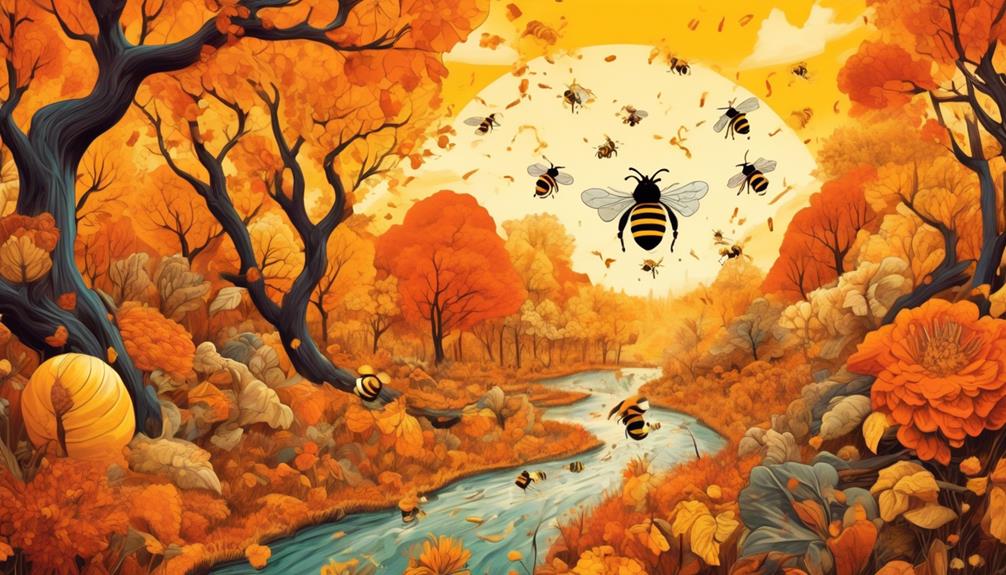
Despite the benefits of autumn flowers, bees in September face a myriad of threats that can hinder their activity and survival.
Pesticides are a significant concern. You see, these chemicals, often used to control other pests, can have a lethal or sublethal effect on bees. Sublethal effects can include impaired foraging or navigational abilities, which can disrupt the bee's role in pollination and its hive's survival.
Parasites also pose a threat. The Varroa mite, for instance, can weaken bees and spread viruses. The cooler September temperatures in some regions signify a challenging time for bees as they must maintain hive temperatures for brood rearing.
Another issue is the decline in floral diversity during this period. Bees rely on a variety of pollen sources for their nutrition. As autumn progresses, fewer flower species bloom, potentially leading to malnutrition issues for the bees.
Lastly, human-caused habitat destruction continues to pose a real threat. Urban development reduces the availability of diverse foraging sites and nesting habitats. Each of these threats can have a cumulative effect on bee populations, underscoring the need for continued research and action to support these vital pollinators.
Frequently Asked Questions
What Are Some Other Insects That Are Active During September?
In September, you'll notice a variety of insects buzzing about, not just bees. Butterflies are still fluttering, especially the Monarch as it migrates. Crickets continue their nighttime serenades. Ladybugs remain active, feasting on aphids. Mosquitoes, too, persist until the first frost. Even dragonflies can be seen darting around bodies of water.
Each insect has its own unique behaviors and adaptations that allow it to thrive during this time of year.
How Does the Weather During September Affect Bee Activity?
You're wondering how September weather impacts bee activity. Well, it's all about preparation for winter.
Moderate temperatures and abundant flowering plants in September provide ideal conditions for bees to gather nectar and pollen. They're busily stocking up food supplies for the hive to survive the coming cold months.
Unfavorable weather, like heavy rain or cold snaps, can reduce their activity. So, it's the balance of resources and conditions that drives their industriousness.
How Does a Bee's Activity in September Compare to Other Months?
In September, you'll notice bees are more active compared to other months. This is because they're preparing for winter. They're busily gathering nectar and pollen to store and feed their colony during the chilly months when flowers aren't blooming.
They're also raising 'winter bees', who are born stronger and live longer. So, you'll see more buzzing around in September than in winter months, but less compared to peak summer when flowers are abundant.
What Can Individuals Do to Support Bees During September?
To support bees in September, you can take several steps in your garden. Firstly, cultivate late-blooming plants that will provide vital nectar during a time when other sources are scarce. These plants will attract bees and ensure they have enough food to sustain themselves. Secondly, it's important to avoid using pesticides in your garden. Pesticides are harmful to bees and can have a devastating impact on their populations. By choosing natural alternatives or practicing organic gardening methods, you can create a safe environment for bees.
In addition to cultivating bee-friendly plants and avoiding pesticides, there are other actions you can take to support bees. Installing a bee house in your garden provides a nesting habitat for solitary bees. These bees are excellent pollinators and can greatly benefit from a designated space to lay their eggs. Another option is to set up a shallow water dish. Bees need access to water, especially on hot days, and a shallow dish with rocks or twigs for them to land on can provide a safe drinking spot.
Lastly, it's crucial to remember not to disturb the natural behavior of bees. Bees are essential for pollination, which is vital for our food production. Avoid swatting or killing bees, and instead, appreciate their presence and the important role they play in our ecosystem. By following these steps, you can create a bee-friendly garden that supports these valuable pollinators.
How Does the Change in Bee Activity During September Affect the Ecosystem?
When bees ramp up their activity in September, you'll notice a significant impact on the ecosystem. They're vital pollinators, ensuring plants reproduce. Without them, there'd be less plant diversity and productivity.
This affects not only plant species, but also the animals that feed on them. So, an increase in bee activity in September can lead to a more robust and diverse ecosystem in the following seasons.
It's a chain reaction that starts with these small, hardworking creatures.
Conclusion
In conclusion, you've seen how bees' life cycle, September's role in pollination, and preparation for winter influence their activity.
Autumn flowers play a critical part, providing essential nectar.
However, threats like pesticides and climate change pose severe challenges.
Hence, understanding these factors allows you to appreciate the complex dynamics of bee activity in September and the essential role they play in our ecosystem.
Let's all contribute to ensuring their survival.

